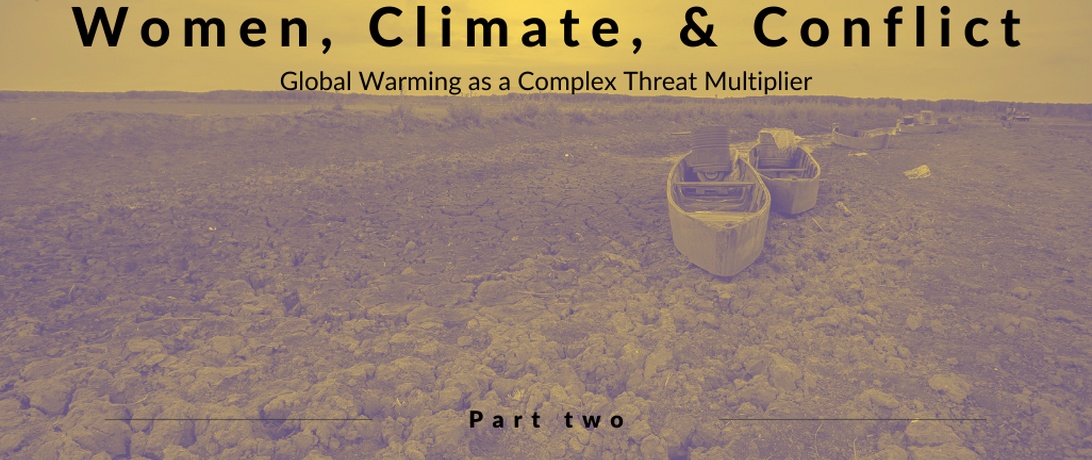
Part two of our guest blog series exploring the nexus of gender, conflict and climate change.
As a guest blog, the views expressed in this publication do not necessarily reflect the views of Our Secure Future or One Earth Future.
Previously, we talked about how climate change impacts all genders, but not equally. When conflict and climate combine, the intersectional nature of their impacts is even more profound. This is the second article in the women-climate-conflict nexus series, and in it, we’re going to explore a climate threat multiplication framework which helps us understand the climate-conflict nexus and how it is likely to impact vulnerable populations differently and more profoundly.
The Complexities of the Climate-Conflict Nexus
Untangling the complexity of the relationship between climate and conflict starts by understanding that climate change in and of itself does not cause conflict. Instead, climate change is known as a threat multiplier because it aggravates already fragile contexts, with the potential to fuel social upheaval and violent conflict. In essence, climate change intensifies existing risks, hazards, disasters, and insecurities, which in combination can increase security threats.
The greatest risks of climate-fueled violence occur in states that are already weak or overburdened. A G7 report on climate and fragility notes, “As a threat multiplier, researchers have found that climate change drives a diverse set of ‘secondary risks, such as violent conflict, political instability, population displacements, poverty, and hunger.’” Importantly, as climate change intensifies over time, it is expected to stress even seemingly stable states and may push many toward conflict.
The following is a sample of conflict situations in which climate may have played a role:
-
Myriad climate-related public health crises may trigger social instability, ultimately leading to conflict. Such factors may include: food insecurity, access to sanitation services, infant/child mortality, health spending per capita, sex ratios, dependency ratios, average life expectancy, population density, etc.
-
Changes in precipitation and increased temperatures in already water-stressed regions may cause drought, which may decrease a region’s agricultural and workforce productivity, causing shocks to GDP. In economically-strained areas, these combined forces could increase civil conflicts.
-
Any of the previous factors may in and of themselves lead to forced migration, which can subsequently cause unrest between migrants and host populations. In fact, a meta-analysis of data on asylum applications for 157 countries between 2006 and 2015 has shown that this kind of population shift has already led to civil unrest.
In all of these situations, underlying conditions left communities unprepared and vulnerable. As climate change transformed local environmental conditions, instability turned to violence. Is it possible to prepare for these eventualities? That’s a problem many climate experts are working to solve.
Understanding the implications of existing sensitivities and knowing how to set policy priorities to address them requires integration of many lines of evidence from science, economics, law, engineering, civil society, and foreign policy. To that end, the US military has been keenly focused on identifying climate-conflict vulnerabilities because of its imperative to develop strategies to deal with threats that could hamper the movement of people and materiel. An added concern is the burden placed on the military by growing involvement in disaster response. Climate change may trigger massive climate disasters that could require significant resources, humanpower, and logistics. Having strategies for coping with the dual responsibilities of military readiness and humanitarian assistance / disaster response (HA/DR) will become all the more important in a warming, crisis-prone world.
The Women-Climate-Conflict Nexus
If you’re a reader of this blog, you no doubt already understand the disproportionate impact conflict has on women. You can therefore imagine the ways in which climate and conflict threats may combine to diminish women’s well-being. Let’s consider some real-world environmental conditions that have led to conflict in the past. For instance, many believe that resource scarcity and severe drought in rural Syrian towns between 2006-2010, combined with governmental failures to mitigate the negative consequences of these environmental changes. These natural resource challenges may have led to civil unrest, eventually shifting the country into civil war [though some refute the connection between climate and the resulting conflict]. Since the outbreak of the violence, millions of Syrians have flowed into internally-displaced persons (IDP) camps where the vast majority of the residents are women and children.
This is only one of many scenarios that could increase the pressure on women living at the intersection of the women, climate, and conflict. The good news is that when women are meaningfully empowered, they play pivotal roles in stabilizing communities and building peace - Syrian women are living this reality in the camps every day. In the following articles in this series, we’ll explore other ways in which women can play active roles in addressing the gender, climate, conflict nexus by digging in to how indigenous women’s wisdom can reduce the load of conflict and climate change on whole communities, and considering whether more women in parliaments results in greater national attention paid to the intersection of gender, climate, and conflict.
Article Details
Published
Written by
Topic
Program
Content Type
Opinion & Insights